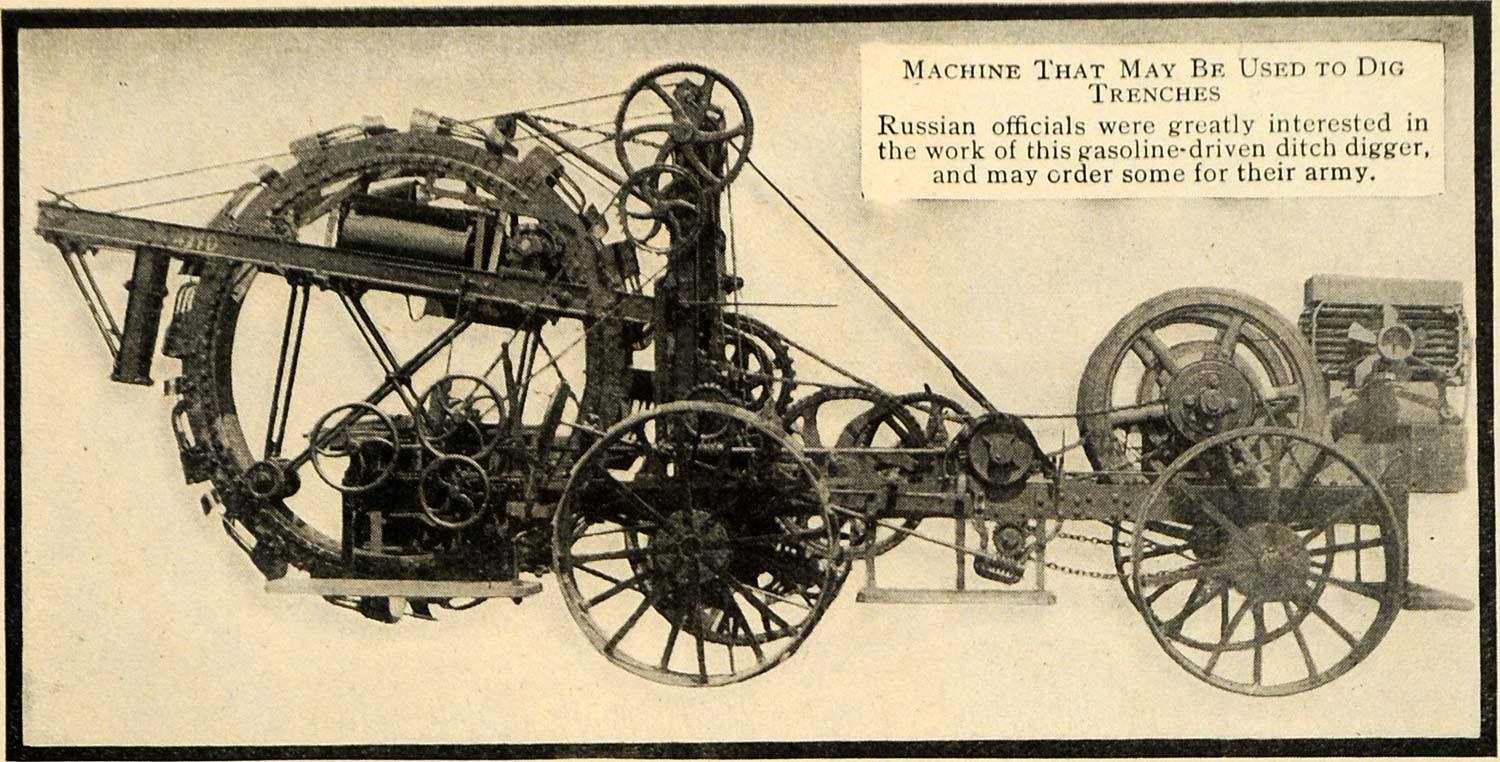Military Trench Digger - A large trench (90-150 tons) can replace up to 15 excavators (20-25 tons). In addition, the trench reduces the minimum required pit width, which is less than cubic meters of excavation per linear meter of production, reducing the excavated area by at least 30% (trench versus excavator).
Produce more with fewer machines and operators, reduce shipping costs and make workplace management easier.
Military Trench Digger

The cost of purchasing a trench is similar to the cost of a set of excavators, however, the cost per linear meter of excavation is about 55-60% higher with a rock splitter than a trencher. Trenchers also have lower operating costs, labor, and maintenance than excavators. You dig pits into smaller pieces, which means you no longer need large containers and dump trucks, and need fewer replenishments, which saves on shipping costs.
War Hacks: How Outgunned Ukraine Finds Ways To Counter Russia
Less engine means less CO2 emissions, and by breaking the rock into smaller pieces when digging the trench, it becomes a usable material, reducing material waste. In recall, filling the panel with an excavator will cost 35-65% more than with a trench. Trenchers also produce less dust, vibration and noise than explosives, so they are more often used in areas near bridges, roads, railways and populated areas.
Vertical wall trenches require less backing material than "V" trench trenches, which increases rear placement. Convenient and low cost. Backfill material is also likely to be well compacted, reducing the risk of abrasion and surface collapse.
The use of explosives is controlled and increasingly restricted, but ammunition can be used everywhere. Last but not least: fewer workers on the job site means less risk of injury or accident. The No. 6 grower is a behemoth, its time machine in the rising World War II. The Trench Digger was Winston Churchill's initiative to break the deadlock of the trench war that left the British wounded during World War I. Not wanting millions more deaths and injuries, Churchill compiled earlier ideas on the use of mechanical means to speed up excavation.
But despite his reputation as a problem solver and great visionary, the First Admiral did not anticipate dramatic changes in the course of World War II. Despite knowing that the project would not be effective, Churchill insisted on oppressing and wasting valuable resources at a time when the UK was in dire need of them.
Tmk 2 Trench Digging Wheel Machine
The year was 1939 and Germany had just invaded Poland. Prime Minister Arthur Neville Chamberlain has appointed Churchill First Lord of the Admiralty to his cabinet. With previous experience, the latter immediately plans to give them a high hand in digging the trench. His original idea was to have an armored car tunnel that would dig holes and dig up unoccupied land where troops and vehicles could move into enemy ranks. But it will not be easy because technology is far from where it is today.
However, Churchill used his privilege to start the project and assigned development to J.H. Hopkins, a famous naval engineer. After submitting countless different designs, the engineers finally got the approval of Churchill. It was the diamond-shaped engine of the first World War I tank, and 240 series were expected to be produced.
To work, they will need at least 1,000 horsepower, which will be shared between moving and digging. They initially considered making Rolls-Royces for the latest Merlin engine (at the time). But the Royal Cambodian Armed Forces kept it first and got the absolute priority.

Sir Harry Ricardo was a famous engineer who was the first to invent an internal combustion engine. He suggested switching to two 600-horsepower Paxman diesel, which is good because it ended up being a better race. With this, the excavation system and the vehicle can be powered independently rather than sharing a single power unit.
Cultivator No. 6: The Cautionary Tale Of The Brit's Trench Digging Machine
To keep the project secret, the tractor has several names to disguise its true purpose, including the NLE Tractor, Tiller 6, White Rabbit 6 and Nellie. Churchill sometimes calls it his mole.
Perhaps in homage to Mark I (referred to as Little Willie), the pattern of water stains is informally known as Nellie (or it may be a play on words from the NLE section). The Nellie has two main parts: the actual digging head and the body that provides the overall movement of the machine.
Weighing about 30 tons for the head alone, it is 9.3 meters (30 feet 6 inches) long, 2.6 meters (8 feet 7 inches) high and 2.2 meters (7 feet 3 inches) wide. It also features a large plow that plows the soil at a height of 2 feet 6, while a rotating cutting cylinder picks up the soil less than 2 feet.
Meanwhile, the body is more than 14 meters long and weighs 100 tons, similar to Mark I. Its 2-foot lane wraps around the entire car at 3.04 miles per hour. The hinge attaches the head to the body, allowing it to rotate freely up and down.
Svatove Area Today, Russian Trench Digger, Possibly Abandoned
The Nellie is visually appealing with overall dimensions of 23.62 meters (77 feet 6 inches) and a weight of 130 tons. One viewer even saw Churchill smile broadly as he watched the prototype show, saying: "... his happy smile almost exploded his cigarette."
Nellie can dig about half a mile at full speed per hour, moving 8,000 tons of soil in the process. It digs a trench 1.5 meters (5 feet) deep and 2.3 meters (7 feet 6 inches) wide as it passes, while the conveyor belt is on top of the tiller on either side of the trench - adding a few feet to the trench. Depth of trench.
The prototype follows Churchill's original idea: Nellie will dig from a friendship line across an uninhabited island and enter a line of enemies, then troops and vehicles can appear and attack the enemy. Nellie will be doing night shifts so she will not be bombed.

Nellie did not see the light of day because of another creator, Cecil Vandepeer Clarke, who came up with a less complicated solution: Dynamics.
Armored Bulletproof Vermeer Trencher For Sale
Well, that's just a factor that makes it never see any action, because Clark's idea was eventually erased because it needed an explosion-proof engine that could have survived the explosion. Also, Nellie has an edge when it comes to stealth. Not to mention that Britain spent too much money to build a cultivator and they fought a war for almost a year. So it is too late to start a new project when it is ready.
What made them abandon Nellie completely was in May 1940, when Nazi Germany occupied France with a rapid military war, leaving the trench war behind them and then releasing them. Use large trenches.
"War-induced changes have had a profound effect on Cultivator VI's practice. It can be useful in both defensive and offensive operations, but it can not be considered the only way to break strong defenses. No, I would suggest the supply minister should be instructed today to halve the scheme. Maybe in a few days it will be cut into quarters. Churchill writes to his assistant military chief Hess shortly after becoming prime minister, Major General Tins Ismay.
However, it was difficult for Churchill to abandon the project. He realized that his "insider" was no longer effective on the battlefield, but he continued with the project until it was completed in 1941 and officially renamed the NLE Trenching Machine Mark I. It lasted another year until it was finally completed in 1943, and only five were built, including the prototype. Four of these items were eventually destroyed immediately after the war, while a fifth survived until 1950 for final disposal. The state needs the money it can get, and Nellie certainly does not need its share.
Russian Tmk 2 Trench Digger.
1 'Righting The Ship' at 2 3 5 Best KA-BAR Knife - Beyond Classic 4 Strange Worlds of KelTec Rifles and Pistols 5 Colt Python - Legends in Service Weapons
Analysis: Why is the West looking at Philippine military bases as a strategic point against Burmese-Chinese rebels, trying to warn our military 13 times about martial law after martial law passed
Adam Brown: Courage and Redemption of the SEAL Full List: Ticonderoga-Class Missile Cruiser to Retire in 2027

Harley davidson military financing, military home financing, foreign military financing program, military flight financing, military auto financing, foreign military financing guidelines, military financing for cars, fmf foreign military financing, military vacation financing, military financing, military computer financing, military car financing
0 Comments